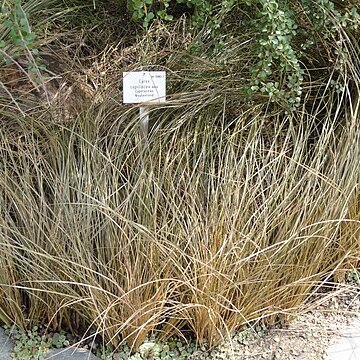Rhizome short. Culms tufted, 15-40 cm tall, slightly scabrous above. Leaves shorter than culm, blades threadlike, 0.5-1 mm wide, flat or involute, smooth; basal sheaths split into brown fibers. Inflorescence 1-spiked, terminal, androgynous; male part distinct, linear, 4-7 mm, 3-7-flowered; female part ovate-orbicular, 3-6 mm, densely 4-10-flowered. Female glumes brown laterally and diluted at middle, elliptic-ovate, ca. 2 mm, 1-3-veined, apex rounded-obtuse. Utricles horizontally patent at maturity, slightly longer than glume, lanceolate-ovate, swollen, trigonous, 2.5-3 mm, with distinct marginal veins and faint veins at middle, sometimes with rusty spots, base rounded-obtuse, apex gradually attenuate into a short beak, orifice slightly emarginate or minutely 2-toothed. Nutlet loosely enveloped, elliptic, trigonous, ca. 1.8 mm; style base not thickened, persistent; stigmas 3. Fl. and fr. Apr-May.
Shortly rhizomatous, tufts flaccid, more or less matted. Culms 4–10–(20) × c. 0.5 mm., us. ± curved, plano-convex to terete, smooth; basal sheaths light brown or grey-brown. Lvs < culms, to 0.5 mm. wide, plano-convex to involute, yellow-green, shining, margins finely scabrid near the acute tip. Infl. a solitary, terminal, androgynous spike 5–8 × 3–4 mm., ovate, ebracteate, or the lowermost glume occ. ± bractiform; female fls 6–10, male fls in a terminal spikelet c. 3 mm. long. Glumes < utricles, ovate, obtuse, pale brown, midrib green. Utricles c. 2 × 1 mm., plano-convex or biconvex, ovoid, green, membr., nerved, margins glab.; beak c. 0.5 mm. long, orifice truncate or notched, glab.; stipe absent. Stigmas 3. Nut c. 1.5 mm. long, bluntly trigonous, ovoid, pale cream, surface distinctly reticulately pitted; style-base persistent.
Rather flaccid yellow-green tufts to 10 cm high. Inflorescence a solitary ebracteate spike 5-8 mm long, male flowers above, female below. Glumes light brown. Utricles green. Stigmas 3.

